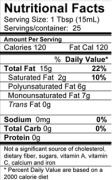A while ago I wrote a blog about using restaurant apps to look up nutritional information and make healthy choices. On NBC’s Today I read an article by Herb Weisbaum which discusses how Consumer Reports decided to test food from various restaurants, including Wendy’s, and compare it to the nutritional information listed on that restaurants website.  Although most of their findings were accurate, there were a few that were not. The article mentions that some of the portion sizes were bigger than what was tested by the restaurant therefore making the nutritional information inaccurate. The Consumer Report article also includes a list the foods tested and how they compared to restaurant findings. Were restaurants blatantly lying or is there wiggle room?
Although most of their findings were accurate, there were a few that were not. The article mentions that some of the portion sizes were bigger than what was tested by the restaurant therefore making the nutritional information inaccurate. The Consumer Report article also includes a list the foods tested and how they compared to restaurant findings. Were restaurants blatantly lying or is there wiggle room?
An article by Tamara Duker Freuman discusses how nutrition labels came to be and why they might not be accurate. Nutritional labels were mandated by the FDA in 1990 under the Nutrition Labeling and Education Act. This required all products have a standard label to allow the consumer more access to nutritional information. However, the FDA allows for a 20% margin of error for information listed. She goes on to discuss a Government Accountability Report from 2008 which found that 90% of 300 nutrition labels tested in the mid-1990’s did fall into the 20% margin of error, but two of most incorrectly labeled nutrients were iron and vitamin A. One-third of the 300 iron content labels were incorrect and almost half of vitamin A were out of the 20% margin of error.
Lesson of the day, be careful when you use apps, review restaurant websites to determine nutritional information listed, or read labels. They may not be entirely true whether its incorrect information or served the incorrect portion size.
What changes do you think the FDA should make to allow access to more accurate nutritional information?

I do not think it is a matter of the FDA changing, I believe it a matter of consumer education. Consumers need to be aware of the standards, deviations, etc, and take responsibility for their own evaluation based on the data and tools available. Industry is not always to blame, for example, auto manufacturers will tell customers that the official MPG rating on a car is too generous, but the way that number is arrived is mandated by the feds and they cannot post anything else.